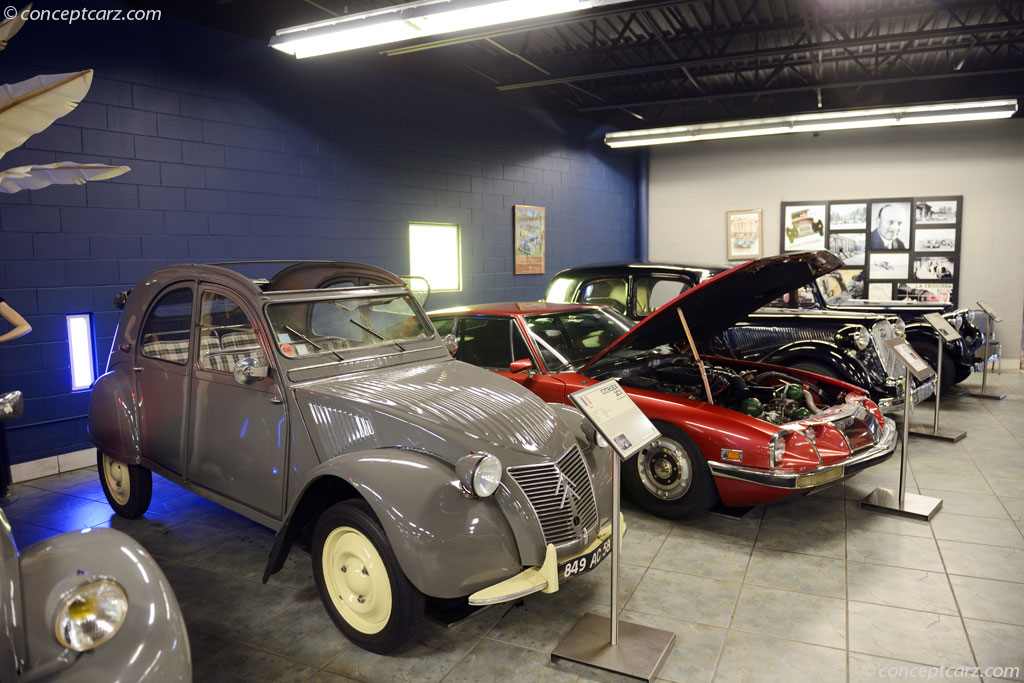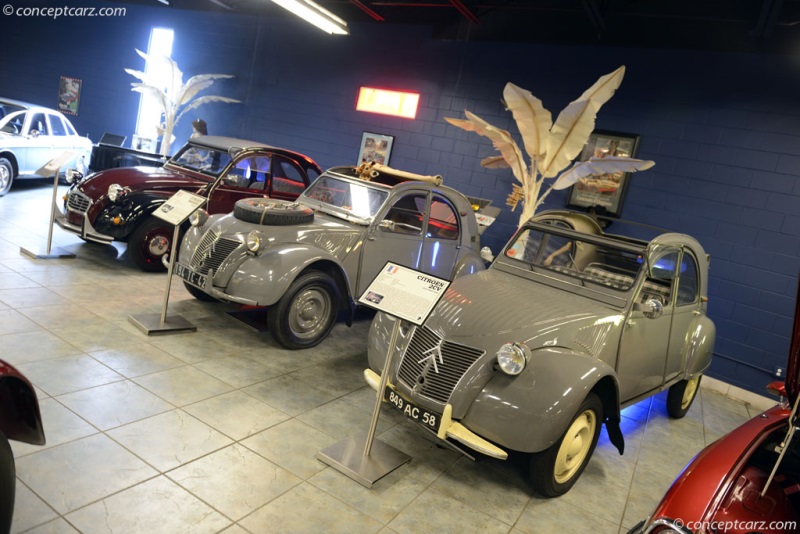1954 Citroen 2CV Navigation
1954 Citroen 2CV Model Years



Sedan
One of the most famous Citroën of all time was the 2CV which was produced from 1948 through 1990. Deux Cheveux, or 'two horses', the 2CV was a popular French vehicle made by Citroen. More than 3,872,583 2CV limousines and even more derivatives during its production run. They most certainly made an impact on the world and especially on the back roads of France where they were the most useful. The earliest models featured a roof that could be rolled back from the windscreen, much like a cabriolet that could be rolled up from the bumper as a trunk lid. The earliest models also could be recognized by the oval ornament on the grill of the one-piece bottom.First introduced at the 1948 Paris Auto Salon, the 2CV Citroën was designed by Pierre Boulanger, and was the most unique and extraordinary design of the auto show. Considered by some to be astonishingly radical for the time, the 2CV was a low-priced, rugged 'umbrella on four wheels'. Incredibly revolutionary, the 2CV was cheap, economical, and very light. With a top speed of 40 mph, the 2CV had an engine that displaced 375cc, produced 9hp from its two cylinders, and was air-cooled.Using no more than 3 liters of gas to travel 100 km, the 2CV was great for two peasants to travel to the market on unpaved roads. The roof could also be lifted up so a hat could be worn while driving. By 1913, the TPV; 'Toute Petite Coiture' or the Very Small Car' was considered drive-able and several prototypes had already been manufactured.
Constructed of a dual H-frame chassis, the body had an airplane-style tube framework and a very thin steel shell. The 2CV engine was powered by a flat-twin air-cooled engine that was designed by Walter Becchia. More responsive, the swinging arm, the fore-aft linked suspension system was much lighter, which enabled the 2CV to be driven at a competitive speed over a plowed field. The seats were basically hammocks that were suspended by the roof by wires. There was only a three-year waiting list after only months of it going on sale.The earliest model had a 375cc engine that developed only 9bhp; which was significantly underpowered. No significant changes were made from 1951 through 1953, but in 1954 the oval on the hood was deleted, and only the chevrons are left. The speedometer also received a lamp for nighttime or when it was dark. An all-new 2CV was introduced in 1955. Called the AZ, the new 2CV featured a larger 425cc engine that developed 12 hp and had a top speed of 49 mph. No real changes were made for 1956, but the following year the steering wheel changed from black into gray and a bigger black screen was offered. A new model was introduced this same year, the ALZ featured aluminum strips on the hood and below the doors. An AZL with a metal trunk lid was introduced in 1958, the AZLM. An all-new 2CV Sahara 4x4 was unveiled and came with the famous two engines. The four-wheel-drive was accomplished by adding an extra engine in the trunk and allowing it to drive the rear wheels, and either or both engines could be selected. The following year some heating options were produced, though most needed is the very effective front windscreen defroster.For the 1960 model year, new tires were introduced for all 2CV's. New 135x380 tires were instead of the 125x400 tires. The Sahara 4x4 also received a new position for its number plate, fuel tanks, and rear lights. The following year a new hood with a smaller grille was added along with separate pieces between the hood and the wings. For 1962 a new engine achieved 14 hp and an estimated top speed of 52 mph. All 2CV's received new bumpers except for the Sahara in 1963. The five models for this year were the AZL, the AZA, AZAM, Mixte, and the Sahara.Rather than the normal 135x380 sized tires, new Michelin X 125x400 tires were used in 1964. The mechanical windscreen driven by a speedometer cable was replaced by an electrical windscreen. To get a different shape, the speedometer moves from the windscreen to the dashboard. All four doors finally opened at the rear in 1965. The Mixte was replaced by the Commerciale which can have a flat trunk installed so that larger more cumbersome objects and can load the car more easily. For 1966 the 2CV received a new grille with horizontal bars. All models except the AZL and Sahara received a third side screen.
In 1970 all Citroen 2CVs received a 12V electrical installation, new taillights, and round front indicators. With a top speed of 63 mph, the Berline 2CV4 came with 435cc and 26 SAE hp engine. With a top speed of 68 mph, the Berline 2CV6 came with 602cc with 33 SAE hp engine. No changes were made from 1971 through 1973. In 1974 new tires replaced the 125X380; the 125X15. The following year a new plastic grille, newly painted steel bumpers, and new square headlights were installed.An all-new 2CV Special was introduced in 1976 and was a much less inexpensive version of the 2CV. This same year a special edition was released call 'Spot' to celebrate the 5 millionth 2 CV. The 2CV was extremely popular now due to the oil crisis while the hp figure is reduced from 28.5 DIN hp to 26 DIN hp. For 1977 the lineup included the Berline 2CV4 Special, Berline 2CV4, and the Berline 2CV6. No changes were made for the 1978 model year.The 2CV6 received square headlights in 1979. The 2CV4 was deleted while the 2CVSpecial received the third side screen and kept the round headlights. The 2CV6 received more increased power through a double choke carburetor to 29hp. For 1980 the 2CV Special received the 602cc engine and all 2CVs received a 6.5-gallon fuel tank rather than the 5.25 tank.For the 1981 model year, a new carburetion adjustment was added along with a rearview mirror, a top speed of 71 mph, and 29 hp. The Charleston, a new 2CV was introduced in '81 with only a total of 5,000 units made. The following year the Charleston was discontinued, but with the addition of chrome headlights and unique upholstery. Finally, all 2CVs received front disc brakes. New seatbelts were offered in 1983. The France 3, Transat, or Beachcomber was introduced in 1984, a special white edition with blue stripes. No changes were made from 1985 through 1990 and the final car was produced in July in a plant in Portugal.Following a successful production run of 42 years, the 2CV; always the epitome of the spirit of France, was finally taken off of the market.By Jessica Donaldson
Michelin and Citroen's managers chose to hide the TPV project from Germany during the German occupation of France during World War II. Several TPV's were hidden at secret locations. One was disguised as a pickup, while others were even destroyed. Six years went by before Boulanger had time to focus on more improvements. Laughed at by the press, the 2CV was called a 'rolling aberration' by Boris Vian, but it was considered to be a revolution in consumer transportation.
In 1967 an all-new special version called the Export was introduced. This version stemmed from the AZAM but was only produced for four months. The following year the Dyane was introduced while only two models of the 2CV were left in the lineup, the Commerciale, and the Berline. In 1968 a 602cc gave 28bhp at 7000 RPM. In 1969 the Berline and Commerciale came with 425cc and 18 SAE hp.
- 1954 Citroen 2CV Menu
- Article
- Image gallery
- Valuation
- Specifications
- Profiles
- Production figures
1954 Citroen 2CV Vehicle Profiles
Recent Vehicle Additions
Performance and Specification Comparison
Price Comparison
$2,275 - $2,975
2CV Specification Comparison by Year
Year
Production
Wheelbase
Engine
Prices
2 cyl., 25.87 CID., 12.00hp
Related Automotive News

MASERATI AND RUXTON AMONG FEATURED MARQUES AT 2014 PEBBLE BEACH CONCOURS d'ELEGANCE
PEBBLE BEACH, Calif. (February 20, 2014) -- Maserati, a marque renowned for its racing greats as well as road cars offering both elegance and sporting performance, takes center stage at the 64th annual Pebble Beach Concours dElegance. The event,...

BESPOKE 911s METICULOUSLY RESTORED FOR CUSTOMERS BY SINGER VEHICLE DESIGN
Newest Handcrafted Customer Car by Singer Salutes50th Anniversary of Original 911, Evoking Passion for a True Automotive Icon
LOS ANGELES – November 20, 2013 – As Singer Vehicle Design (SVD) tonight hosts a Los Angeles viewing of its la...

Singer Vehicle Design Celebrates 50Th Year Of 911 With Latest ‘Re-Imagined' Debut At Quail
Newest Handcrafted Restored Customer Car by Singer Evokes Past Racing Glories of Porsche, With State-of-the-Art Content and Peerless Execution.
LOS ANGELES – August 1, 2013 – When Singer Vehicle Design (SVD) displays the latest handcraf...

BMW CONCEPT NINETY
Cernobbio. 90 years of BMW Motorrad, 90 years of two-wheeled history – hardly another motorcycle manufacturer can boast such a longstanding and successful heritage as BMW. The BMW R 90 S likewise has cause to celebrate the BMW Motorrad design icon turns...

Auctions America By RM's Spring Carlisle Auction Kicks off 2012 Northeastern U.S. Collector Car Season
Auctions America by RM will return to the Carlisle Expo Center in Carlisle, Pennsylvania, on April 26-27, 2012, to kick off the collector car season for the Northeastern U.S. with its Spring Carlisle auction.
Featuring nearly 300 American hot rods,...








